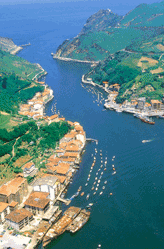The worldwide gas industry
>
Improvements in infrastructure
>
LNG facilities in Europe
LNG facilities in Europe
The second offshore regasification terminal at Rovigo (north-eastern Italy) is about to be started up. A further dozen or so projects for LNG terminals are currently on the table, some of which involve Spanish companies.
Endesa, for example, is involved in the regasification plant at Livorno, another offshore facility. In the middle of last year, the company Gas Natural received a favourable environmental report in relation to its regasification plant at the port of Trieste-Zaule, in the north of Italy. The project is planned to come into operation in 2012.
The governments of Italy and Greece signed a declaration of intent at the beginning of 2008 in relation to the construction of an undersea gas pipeline between their two countries, covering 206 km and at a maximum depth of 1,380 m. If it materialises, this project, known as Poseidon, would be the third to go into development between the two countries. The others are the TAP and the IGI projects which terminate in Otranto.
Start-up of what would be the third terminal in France (Fos Cavaou LNG, in the southeast of the country) has been delayed until 2009, a year later than planned.
Three further projects for LNG terminals are at the permit and finalisation stage. These are to be located at Dunkirk and Antifer in the north, and Le Verdon in the southwest. The first and last of these are scheduled to enter operation in 2013. A decision regarding investment in the Dunkirk project will be taken during 2009.
The first consignment of LNG to leave a European liquefaction terminal (the Snohvit terminal on Melkoya, an island off the north of Norway) arrived at the US terminal in Cove Point on 21 February 2008. This was one of the main European events of the year.
One of the clients for LNG consignments from this Norwegian terminal is Spain, under an agreement signed several years ago by Iberdrola.Also in Norway, the company Statoil has approved a plan to extend the useful life of the Troll field, the most important in western Europe. Gas output from this field totals around 30 bcm a year, and the new investment programme is expected to keep it in operation until 2060.
Construction began in mid-2008 on the first LNG terminal in the Netherlands.
This is a joint venture between Vopak LNG and Gasunie and is located outside the port of Rotterdam. Completion is scheduled for mid-2011.
The initial capacity of this terminal (9 bcm/year) is to be increased to 12 bcm as the result of an undertaking signed by the developers and E.On Ruhrgas. The latter company has postponed the construction of its own terminal at Wilhelmshaven (Germany). The aim is to supply gas from this terminal to the company’s customers in Germany and north-western Europe.
Plans continue to build a terminal at Swinoujscie in Poland, on the Baltic coast close to the border with Germany. The facility will come into operation at the end of 2012.
Other European countries currently have plans to build regasification terminals, some of them with no previous experience in the field. These include Lithuania (a viability study was started at the end of 2008), Albania (also in the planning stages; the facility will in principle be built close to Fieri, south of Tirana, with assistance from Italy) and Cyprus, where the authorities have reaffirmed their commitment to import LNG.

Annual Report 2.008: Sedigas - The Spanish Gas Association


